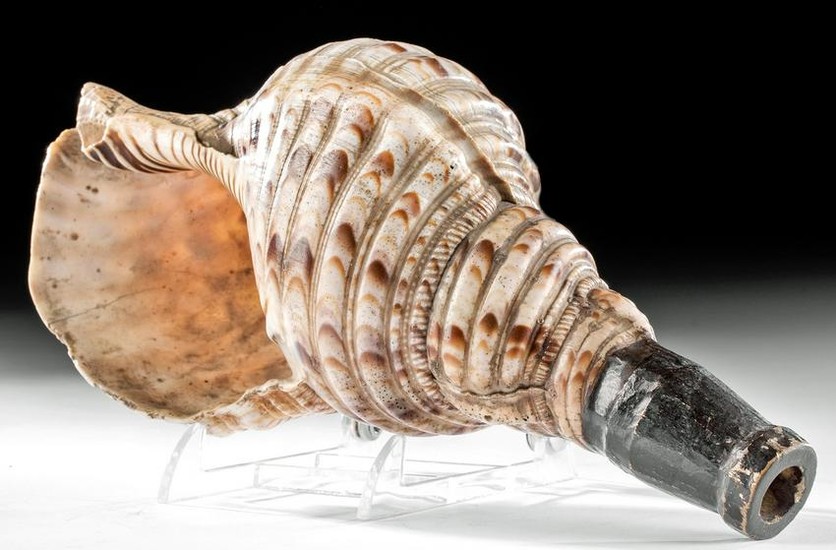Japanese Edo / Meiji Shell Horn Trumpet - Horagai
**First Time At Auction**
East Asia, Japan, late Edo to early Meiji period, ca. mid to late 19th century CE. A beautiful example of a mollusk shell horn known as a horagai (also hora), a trumpet formed from the large shell of a Triton's trumpet (Charonia tritonis) shell. The conical instrument has a spiraling body with a broad tone hole, and a wooden mouthpiece is attached to the narrow end. Horagai are traditionally used by the Yamabushi (literally "mountain prostrate"), ascetic warrior monks of the Shugendo religious tradition who lived in the mountains. The Yamabushi would use horagai to transmit their movements throughout the mountains. During times of conflict in the Feudal era, shell trumpets were used to direct troop movements and were called jinkai (literally "war shell"). Lucite display stand for photography purposes only. Size: 10.375" L x 4.625" W (26.4 cm x 11.7 cm)
For a stylistically similar example of a horagai with a wooden mouthpiece, please see The Metropolitan Museum of Art, accession number 46.34.65.
Provenance: private J.H. collection, Beaverton, Oregon, USA, acquired in June 2016; ex-private Onomichi, Hiroshima, Japan collection
All items legal to buy/sell under U.S. Statute covering cultural patrimony Code 2600, CHAPTER 14, and are guaranteed to be as described or your money back.
A Certificate of Authenticity will accompany all winning bids.
We ship worldwide to most countries and handle all shipping in-house for your convenience.
#152030
Condition Report: Minor nicks to exterior and peripheries of shell as well as wooden mouthpiece, with a couple of stable hairline fissures, otherwise intact and very good. Smooth patina throughout. Horn produces an incredibly loud sound if played correctly.
View it on
Estimate
Time, Location
Auction House
**First Time At Auction**
East Asia, Japan, late Edo to early Meiji period, ca. mid to late 19th century CE. A beautiful example of a mollusk shell horn known as a horagai (also hora), a trumpet formed from the large shell of a Triton's trumpet (Charonia tritonis) shell. The conical instrument has a spiraling body with a broad tone hole, and a wooden mouthpiece is attached to the narrow end. Horagai are traditionally used by the Yamabushi (literally "mountain prostrate"), ascetic warrior monks of the Shugendo religious tradition who lived in the mountains. The Yamabushi would use horagai to transmit their movements throughout the mountains. During times of conflict in the Feudal era, shell trumpets were used to direct troop movements and were called jinkai (literally "war shell"). Lucite display stand for photography purposes only. Size: 10.375" L x 4.625" W (26.4 cm x 11.7 cm)
For a stylistically similar example of a horagai with a wooden mouthpiece, please see The Metropolitan Museum of Art, accession number 46.34.65.
Provenance: private J.H. collection, Beaverton, Oregon, USA, acquired in June 2016; ex-private Onomichi, Hiroshima, Japan collection
All items legal to buy/sell under U.S. Statute covering cultural patrimony Code 2600, CHAPTER 14, and are guaranteed to be as described or your money back.
A Certificate of Authenticity will accompany all winning bids.
We ship worldwide to most countries and handle all shipping in-house for your convenience.
#152030
Condition Report: Minor nicks to exterior and peripheries of shell as well as wooden mouthpiece, with a couple of stable hairline fissures, otherwise intact and very good. Smooth patina throughout. Horn produces an incredibly loud sound if played correctly.



